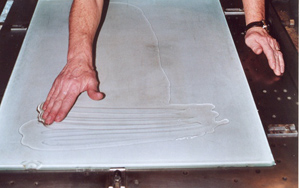
- There are several grades of photographic gelatins : In a past still close enough, it seems that there was a range of hardness of this type of gelatins relatively large, with a about ten choices. We find commonly three qualities, tender, middle hard, or extra hard, but intermediate hardnesses can be can be sometimes found. However, the sensible mixture of three basic qualities allows to modulate the preparation according to the temperature and to the ambient hygrometry, to obtain the good formulation for the collotype. About it, I would point out that judicious control of the temperature of the workshop (22 ° C) and humidity avoid to make these changes in the preparation – which is always desirable.
- Gelatin – animal substance : Regarding the use of gelatin, it is good to remember that it is a substance of animal origin, it is important to provide throughout its use. The main precaution is to not too warm during the operations of preparation and dried. The threshold of 55 ° seems to be the limit to not exceeded. Non-compliance with this requirement leads to failure whose origin is not very easy to identify. Similarly, we should not incorporate more than 6 times its weight in water (it is simply to follow the proportions that I discuss below, not to miss the preparation). In any event, it is good practice to soak the gelatine in cold water (room temperature) for a minimum of 3 hours before putting it in a water bath (In cold water softens it, inflates it, but does not dissolve it without the intervention of the heat).
- Relations between the gelatin and the delicacy of printings : the more a gelatin is soft, the more the images will be fine during printing, but more fragile will be the matrix. The more the water of the bath of draining is warm (see: putting of the plate tanned in the bath of draining) (ideal temperature in the neighborhood of 10 °, but which never has to exceed 16 °c), the more there will be of the grain (increase of the thickness of the grains of the printed image – seen in the magnifying glass – réticulation). The more the gelatin is tanned, the more the image will have of the grain.